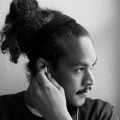Loopy Pro: Create music, your way.
What is Loopy Pro? — Loopy Pro is a powerful, flexible, and intuitive live looper, sampler, clip launcher and DAW for iPhone and iPad. At its core, it allows you to record and layer sounds in real-time to create complex musical arrangements. But it doesn’t stop there—Loopy Pro offers advanced tools to customize your workflow, build dynamic performance setups, and create a seamless connection between instruments, effects, and external gear.
Use it for live looping, sequencing, arranging, mixing, and much more. Whether you're a live performer, a producer, or just experimenting with sound, Loopy Pro helps you take control of your creative process.
Download on the App StoreLoopy Pro is your all-in-one musical toolkit. Try it for free today.




Comments
Setting the timebase after MIDI notes. Great idea!
Yeah, it’s pretty brilliant.
Developers who listen to helpful suggestions are the best.
David is definitely one of the most responsive devs I’ve talk to. 👊🏼
I don't know if any desktop wavetable creator/editors use this midi method for isolating single cycles of wave forms. But I think this might make a good method for a wavetable editor if it could utilize this principle as a way to capture single cycles from synth instruments.
Lots of ways to build wavetables with that kind of feature...
Choose one wavetable frame and it displays as an oscilloscope view. Play a sound and tap a capture to wavetable button. Then move forward a number of frames and capture another wave from another sound. Capture a sequence waveforms at various intervals in the table, and then choose an algorithm for morphing between the frames.
Or.. Program / find an evolving synth sound. Then set the wavetable editor to auto-capture a sequence of waves to the table by selecting a capture interval to occur once every X number of wave cycles. That way you'd end up with 256 "unique" waves in a table, taken from throughout the duration of a sound.
Combine this "interval capture" feature with the user manually tweaking filters and effects and it could lead to some crazy sound design possibilities.
....
That’s an interesting way of doing it.
I’ve actually pot wavetable a together myself before in Cubasis. I then put that into Vancouver in gadget. Might interest you?
Windows 10 was your idea!
Aw, there’s probably a really good joke here, but I’m too dumb to get it. 😅😓
Cool video, and wavetable demonstration.
Due to current lack of wavetable creation Apps for iPad, I've been using a Mac desktop App called vital wavetable synth. Vital has an editor that provides tools for building custom wavetables. It also has morph/interpolation algorithms.. so complete 256 frame wavetables can be constructed by auto-filling the frames between the frames the user "draws".
In your demonstration you used Adventure Kid single cycle waveforms, and that makes sense because drawing lots of custom single cycle waves takes time.
But.. if a wavetable editor used this new oscilloscope method for isolating then capturing single waveforms, then writing the captured from audio waves directly into a wavetable...
It could make the process of making custom wavetables really fun, intuitive, and easy.
They ran some cheesy adverts for Windows 10 where supposedly everyday people said “Windows 10 was my idea”. I was gently poking fun at the similarity 😊
I guess that explains all the crap ideas...